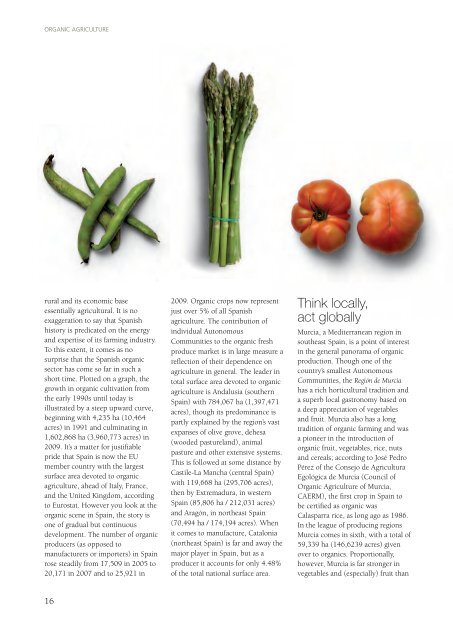Flan de la casa con natas en texturas - Foods From Spain
Flan de la casa con natas en texturas - Foods From Spain
Flan de la casa con natas en texturas - Foods From Spain
Create successful ePaper yourself
Turn your PDF publications into a flip-book with our unique Google optimized e-Paper software.
ORGANIC AGRICULTURE<br />
rural and its e<strong>con</strong>omic base<br />
ess<strong>en</strong>tially agricultural. It is no<br />
exaggeration to say that Spanish<br />
history is predicated on the <strong>en</strong>ergy<br />
and expertise of its farming industry.<br />
To this ext<strong>en</strong>t, it comes as no<br />
surprise that the Spanish organic<br />
sector has come so far in such a<br />
short time. Plotted on a graph, the<br />
growth in organic cultivation from<br />
the early 1990s until today is<br />
illustrated by a steep upward curve,<br />
beginning with 4,235 ha (10,464<br />
acres) in 1991 and culminating in<br />
1,602,868 ha (3,960,773 acres) in<br />
2009. It’s a matter for justifiable<br />
pri<strong>de</strong> that <strong>Spain</strong> is now the EU<br />
member country with the <strong>la</strong>rgest<br />
surface area <strong>de</strong>voted to organic<br />
agriculture, ahead of Italy, France,<br />
and the United Kingdom, according<br />
to Eurostat. However you look at the<br />
organic sc<strong>en</strong>e in <strong>Spain</strong>, the story is<br />
one of gradual but <strong>con</strong>tinuous<br />
<strong>de</strong>velopm<strong>en</strong>t. The number of organic<br />
producers (as opposed to<br />
manufacturers or importers) in <strong>Spain</strong><br />
rose steadily from 17,509 in 2005 to<br />
20,171 in 2007 and to 25,921 in<br />
16<br />
2009. Organic crops now repres<strong>en</strong>t<br />
just over 5% of all Spanish<br />
agriculture. The <strong>con</strong>tribution of<br />
individual Autonomous<br />
Communities to the organic fresh<br />
produce market is in <strong>la</strong>rge measure a<br />
reflection of their <strong>de</strong>p<strong>en</strong><strong>de</strong>nce on<br />
agriculture in g<strong>en</strong>eral. The lea<strong>de</strong>r in<br />
total surface area <strong>de</strong>voted to organic<br />
agriculture is Andalusia (southern<br />
<strong>Spain</strong>) with 784,067 ha (1,397,471<br />
acres), though its predominance is<br />
partly exp<strong>la</strong>ined by the region’s vast<br />
expanses of olive grove, <strong>de</strong>hesa<br />
(woo<strong>de</strong>d pasture<strong>la</strong>nd), animal<br />
pasture and other ext<strong>en</strong>sive systems.<br />
This is followed at some distance by<br />
Castile-La Mancha (c<strong>en</strong>tral <strong>Spain</strong>)<br />
with 119,668 ha (295,706 acres),<br />
th<strong>en</strong> by Extremadura, in western<br />
<strong>Spain</strong> (85,806 ha / 212,031 acres)<br />
and Aragón, in northeast <strong>Spain</strong><br />
(70,494 ha / 174,194 acres). Wh<strong>en</strong><br />
it comes to manufacture, Catalonia<br />
(northeast <strong>Spain</strong>) is far and away the<br />
major p<strong>la</strong>yer in <strong>Spain</strong>, but as a<br />
producer it accounts for only 4.48%<br />
of the total national surface area.<br />
Think locally,<br />
act globally<br />
Murcia, a Mediterranean region in<br />
southeast <strong>Spain</strong>, is a point of interest<br />
in the g<strong>en</strong>eral panorama of organic<br />
production. Though one of the<br />
country’s smallest Autonomous<br />
Communities, the Región <strong>de</strong> Murcia<br />
has a rich horticultural tradition and<br />
a superb local gastronomy based on<br />
a <strong>de</strong>ep appreciation of vegetables<br />
and fruit. Murcia also has a long<br />
tradition of organic farming and was<br />
a pioneer in the introduction of<br />
organic fruit, vegetables, rice, nuts<br />
and cereals; according to José Pedro<br />
Pérez of the Consejo <strong>de</strong> Agricultura<br />
Egológica <strong>de</strong> Murcia (Council of<br />
Organic Agriculture of Murcia,<br />
CAERM), the first crop in <strong>Spain</strong> to<br />
be certified as organic was<br />
Ca<strong>la</strong>sparra rice, as long ago as 1986.<br />
In the league of producing regions<br />
Murcia comes in sixth, with a total of<br />
59,339 ha (146,6239 acres) giv<strong>en</strong><br />
over to organics. Proportionally,<br />
however, Murcia is far stronger in<br />
vegetables and (especially) fruit than


